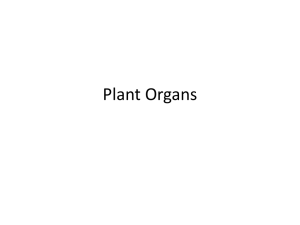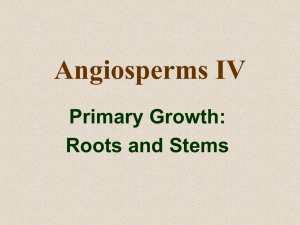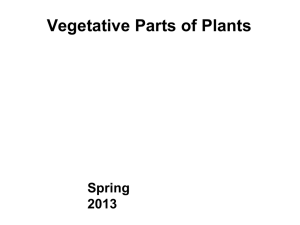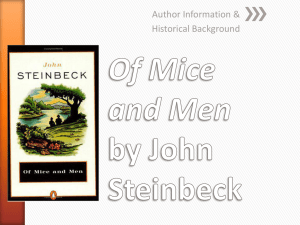Roots, Stems, and Leaves
advertisement
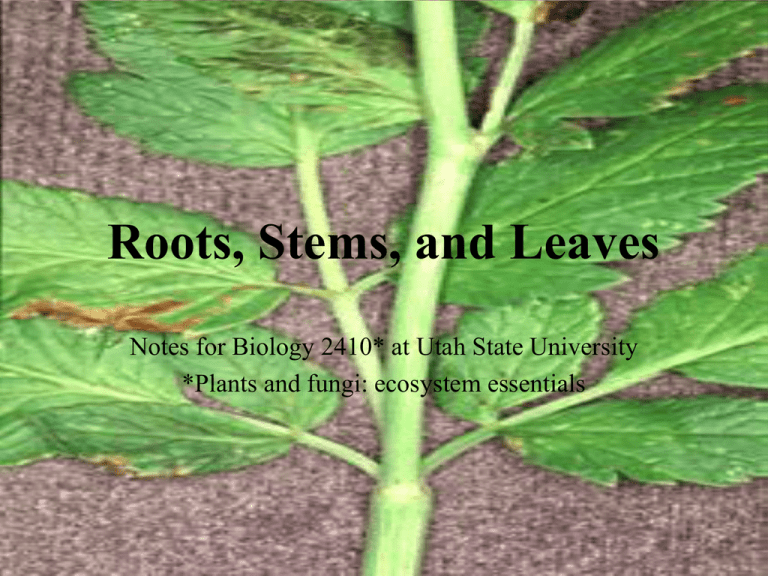
Roots, Stems, and Leaves Notes for Biology 2410* at Utah State University *Plants and fungi: ecosystem essentials Life before reproduction • Reproduction is essential to a species’ success • Plants have to grow to the point that they are mature enough, and healthy enough, to reproduce. • Roots, stems, and leaves are the workhorse structures of plants. Roots • Obtain water and dissolved nutrients from soil and mycorrhyzae • Anchor plant • Are point of contact for mycorrhizal fungi Types of roots • Primary root - from embryo • Secondary roots –from primary root • Adventitious roots – from leaf nodes – May be modified for support or defense or … Aerial root Adventitous roots Root structures • Tap roots – from primary root • Fibrous roots – from adventitious or secondary roots • Tuberous roots – thickened ROOTS – Tubers are thickened stems http://www.museums.org.za/bio/images/enb7/enb07429x_beetroot.jpg http://trc.ucdavis.edu/egsutter/plb171/VisualMaterial/largePhotoSStruc/TubersPic/tuber-potato99lable.jpg Tuberous root Stem, not root Rhizomes: underground stems, not roots • Rhizomes have nodes and reduced leaves • Rhizomes often root at nodes • Rhizomes enable a plant to spread and reproduce • Rhizomes are most common in mesic and wet habitats Prickles Stems • Hold up above ground parts of plant; transmit signals • Have leaves and may have branches • Woody or herbaceous • Leaves and branches may be – Opposite – Alternate – Whorled (Verticillate) • May have hairs, prickles, thorns, spines Alternate Spines Caudex (pl.: caudices) • Woody stem that does not or only scarcely extends above ground Woody stems also have … • Lenticels • Leaf scars • Bark http://www.virtualherbarium.org/treepuzzle/chars/LENTICELS_ABUNDANCE.html http://www.science.siu.edu/plant-biology/PLB304/TwigPics/AcerSaccharinum.jpg http://home.tiscali.nl/picturesandadicons/dtp/1024x768dtp3/Bark.jpg Leaves – absolutely vital • Evaporation surface (essential to nutrient transport) • Energy converters – Absorb sunlight – Take in CO2 from air – Release O2 as byproduct • Food and shelter for others http://www.huntington.org/BotanicalDiv/TitanPix/leaves.jpg Leaf structure • Simple – Lobed, Divided, pinnatifid, palmatifid, pedate, cleft, parted http://www.esb.utexas.edu/mbierner/bio406d/images/pics/ast/Ambrosia%20psilostachya%20lf2.jpg http://www.discoverlife.org/nh/tx/Plantae/Dicotyledoneae/Aceraceae/Acer/saccharinum/images/JP80036_61.Simple_leaf_position:Opposite.320.jpg Compound • Palmately • Pinnately – Odd pin – Even pinnate Flat, revolute, involute Revolute Leaf margins • Entire, Crenate, Dentate, Serrate • Crispate or undulate • Spinose Crenate margins Dentate margins Spinose leaf Crisped leaf Undulate leaves Serrate margins Leaf apices http://www.eeob.iastate.edu/classes/botany306/terminology/vegetative/images/leaves/apices.jpg Leaf bases and attachment http://www.inhs.uiuc.edu/~kenr/prairieplant.terminology/leaf_bases1.jpg Hair types • • • • • • • • Simple Stellate Dolabriform Scalelike Glochidiate Barbed Plumose Glandular Vestiture (surface) • Where is it? • Lots of words – problem is COMMON understanding



